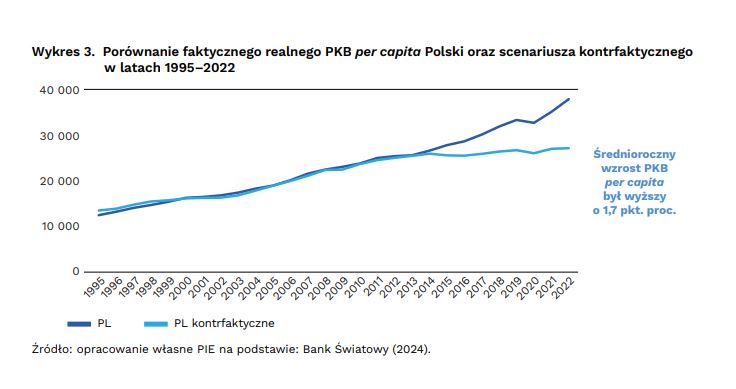Poles are on average 40% richer than they would have been if the country had not joined the European Union, according to a new report by the Polish Economic Institute, published ahead of next month’s 20th anniversary of Poland’s EU accession.
PIE’s analysts calculated that Poland’s GDP per capita in purchasing power parity (PPP) terms – a measure of economic activity taking account of a country’s population size and cost of living – was in 2022 39.6% higher than if the country had not joined the EU.
Among the eight eastern member states that joined in 2004, only Lithuania (60.3%) was found by PIE to have had a bigger premium from EU membership than Poland. They were followed by Latvia (32.2%), Slovakia (18.2%), Hungary (13.4%), the Czech Republic (8.4%), Estonia (0.4%) and Slovenia (0.1%).

How much higher was PPP GDP per capita at constant prices in 2022 as a result of EU membership (in per cent)?; Source: PIE
To create a model enabling them to calculate the benefits of EU membership, PIE used what is known as the synthetic control method, which assumes the creation of a counterfactual scenario based on the reproduction of the country under study from among countries with similar characteristics that remained outside of the EU.
Its analysts found that Poland’s average annual growth in GDP per capita at PPP between 2004 and 2022 of 4.2% would have been 1.7 percentage points lower if Poland had pursued development outside the EU.
“Should it have remained outside the EU, the Polish standard of living, as measured by GDP per capita, would be [in 2022] at the same level as it was between 2014 and 2015,” the report reads.

Comparison of Poland’s actual real GDP per capita (dark blue line) and the counterfactual scenario (light blue line) from 1995 to 2022; Source: PIE
For the countries that joined the EU in 2004, “one of the most significant factors that influenced the economic development of our region was insertion into EU supply chains”, said Marek Wąsiński, head of PIE’s global economy team.
“This has brought an influx of foreign investment, led to a fivefold increase in the value of merchandise exports and increased their level of sophistication,” he added.
“EU integration turned Central Europe into an export hub,” continued Wąsiński. “Although the majority of products and services were supplied to the EU, almost half of the added value eventually found its way – also through indirect exports – to markets around the world.”
Poland has been the biggest economic beneficiary of EU membership among the eastern member states that have joined the bloc since 2004, a new report shows.
Over that period, its economy has doubled in size, outpacing all other countries in the region https://t.co/keCA2fZlHV
— Notes from Poland 🇵🇱 (@notesfrompoland) April 3, 2024
In all eight countries in the region, indicators measuring quality of life have increased significantly over the last two decades, PIE notes.
In the case of Poland, life expectancy increased to 77 years in 2022 from 75 in 2004, the average number of years spent in school increased to 15.9 from 14.8, and per capita PPP income increased to $35,151 from $17,708 in 2004.
“In addition, the risk of poverty fell below the EU average in five of the eight member states analysed, and the perception of corruption decreased everywhere except Hungary and Slovenia,” writes PIE.
In a report published last month, analysts at Polish bank Pekao calculated that over the past 20 year Poland recorded the highest cumulative real GDP growth among the eastern member states that have joined the bloc since 2004, with the country’s GDP doubling between 2004 and 2022.
Economist @pwlbukowski challenges six myths about inequality in Poland, including:
1. Income inequalities are low by European standards
2. Economic growth has "lifted all boats equally"
3. The economic gender gap is smallRead the full article here ⬇️ https://t.co/ShOgrL75Dx
— Notes from Poland 🇵🇱 (@notesfrompoland) January 24, 2024

Notes from Poland is run by a small editorial team and published by an independent, non-profit foundation that is funded through donations from our readers. We cannot do what we do without your support.
Main image credit: Adam Borkowski/Unsplash

Alicja Ptak is senior editor at Notes from Poland and a multimedia journalist. She previously worked for Reuters.



















